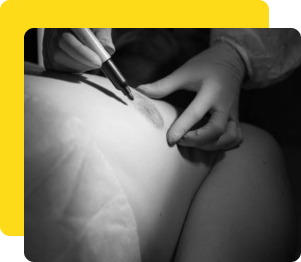Gynecomastia Treatment
Gynecomastia is a condition that affects many men around the world. Characterized by the development of breast tissue, the condition can be physically and emotionally uncomfortable. If you’re one of the many men suffering from this condition, you’re probably wondering what you can do about it. Luckily, gynecomastia surgery in Turkey will help you regain your attractive physical appearance and confidence. In this guide, we’ll explore the various techniques and recovery methods available to you so that you can make an informed decision about your treatment plan.
Procedure: Gynecomastia
Duration: 1 – 2 hours
Length of Stay in Hospital : 1 – 2 nights
Cost in Turkey: €3000 – €3250
Anesthesia: General anesthesia
Success Rate: 90% – 95%
Final Results: 6 months
Scars: Invisible
Pain: Slight
What is Gynecomastia?
Gynecomastia is a condition that can cause the growth of breast tissue in men.
Although it can occur naturally during puberty or with age, it can also be a side effect of certain medications, hormone imbalances, or health conditions.
If you’re experiencing “man boobs”, various treatment options are available to help you feel more comfortable and confident.
Some men use a gynecomastia compression vest or gynecomastia vest to flatten their chest, while others explore non-surgical treatments such as hormone therapy or lifestyle changes.
Surgical intervention, such as “man boobs” surgery in Turkey, is another option for those who want more immediate results.

What Causes Gynecomastia?
- Hormonal imbalances
- Obesity
- Certain medications
- Illegal drug use
- Genetics
- Aging
What are The Signs and Symptoms of Gynecomastia?
Gynecomastia symptoms can include:- Swollen or enlarged breast tissue
- Tenderness or pain in the breast area
- Nipple discharge in one or both breasts
- Uneven breast tissue distribution
- An increase in the diameter of the areola (the pigmented skin surrounding the nipple)
How is Gynecomastia Surgery Performed?
Anesthesia: You will be given general anesthesia or local anesthesia with sedation to ensure you don’t feel any pain during the surgery.
Incision: The surgeon will make an incision around the areola or in the armpit, depending on the extent of the gynecomastia.
Glandular tissue removal: The surgeon will remove any excess glandular tissue and fat from the chest area.
Closing the incision: The incision will be closed with sutures and covered with a dressing.
Recovery: You will be able to return home the same day after Male breast reduction, but you will need to avoid strenuous activity for a few weeks to allow for proper healing.
Gynecomastia Treatment Recovery and Aftercare
One of the most important tools for post-surgical recovery is a gynecomastia compression vest or gynecomastia vest, which can help reduce swelling and support the chest during the healing process. Other tips for a successful recovery and aftercare include:- Take any prescribed medications as directed by your surgeon to manage pain and reduce the risk of infection.
- Rest and avoid strenuous activities for the first few weeks after surgery to allow your body time to heal.
- Wear your compression vest as directed by your surgeon to promote proper healing and prevent complications.
- Attend all scheduled follow-up appointments with your surgeon to monitor your progress and address any concerns or issues.
- Maintain a healthy diet and stay hydrated to support your body’s healing process.
- Avoid smoking and alcohol consumption, as these can impede the healing process and increase the risk of complications.
Risks and Complications of Gynecomastia Surgery
Here are some key factors to keep in mind:
Bleeding and hematoma: These are the most common complications associated with any surgery. If you experience excessive bleeding, your surgeon may need to perform additional procedures to stop the bleeding and prevent further complications.
Infection: In rare cases, an infection may develop at the incision site. Your surgeon will likely prescribe antibiotics to prevent infection, but if it does occur, you may need additional treatment.
Scarring: While most incisions heal well, some may leave visible scars. Your surgeon will work to minimize scarring as much as possible, but it’s important to understand that scarring is a potential risk of the procedure.
Nipple sensation changes: Some patients may experience a temporary or permanent change in nipple sensation following surgery.
Anesthesia risks: Any surgery that requires anesthesia carries some degree of risk. Your surgeon will discuss the potential risks associated with anesthesia with you prior to the procedure.
Discuss these potential risks and complications with your surgeon and have a clear understanding of what to expect before, during, and after your surgery.
Gynecomastia Prevention and Management
Firstly, maintaining a healthy lifestyle by following a balanced diet and exercising regularly can help reduce the risk of developing “man boobs”. Additionally, avoiding the use of drugs or substances that can cause hormonal imbalances can also prevent the condition.
If you are already experiencing gynecomastia, seeking medical advice from a qualified professional is the first step toward managing the condition. Depending on the severity of the condition, treatment options range from medication to surgery.
Conclusion
Surgery can be a highly effective solution for those looking to address the physical and emotional impacts of “man boobs”.
However, it is important to understand the risks and complications associated with the procedure and to carefully consider whether surgery is the right choice for you, or consider gynecomastia treatment without surgery.
With the guidance of a qualified surgeon and a commitment to a healthy lifestyle, managing gynecomastia is possible.
If you want to learn more about gynecomastia surgery cost procedures and treatments, be sure to check out our series of treatment guides.
With comprehensive information and expert advice, we can help you make an informed decision about your health and well-being. Learn more in-depth about Gynecomastia procedures now!
Frequently Asked Questions (FAQs)
Lifestyle changes such as regular exercise and a balanced diet can help reduce the size of breast tissue. Certain medications such as hormone therapy or medication to reduce estrogen levels may also be prescribed. However, surgery may be required in some cases to fully address the condition.
Gynecomastia can occur due to an imbalance of hormones, including low testosterone. However, it can also be caused by other factors such as medication, drugs, or genetics.
If left untreated, gynecomastia can lead to emotional distress, pain, and tenderness in the chest area, and in rare cases, breast cancer. Seeking medical advice and treatment is recommended.
Gynecomastia typically occurs in three stages, ranging from minor breast tissue growth to significant enlargement. The stages are classified based on the amount of breast tissue and skin that is present in the chest area.
While alcohol does not directly cause gynecomastia, excessive consumption can contribute to hormonal imbalances that can increase the risk of developing the condition. Additionally, alcohol can also lead to weight gain, which can exacerbate the appearance of gynecomastia.
